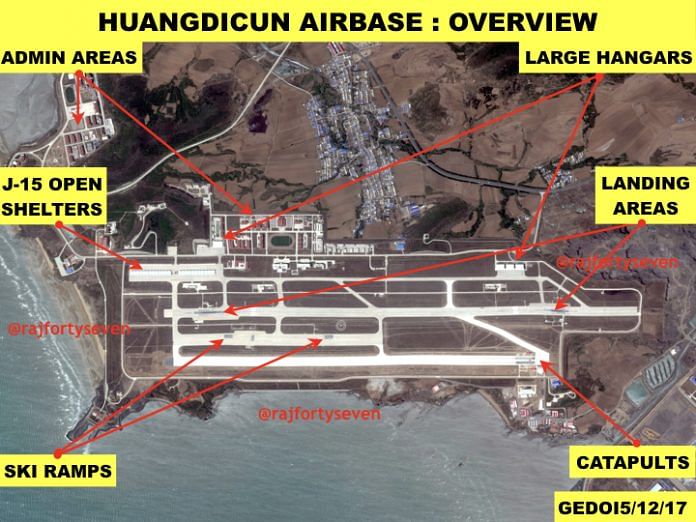It has 24 aircraft shelters, 3 large hangars possibly for UAVs, one hangar for airborne early warning and control (AEWC) planes, among others.
China’s dream is Chairman Xi Jinping’s vision to achieve superpower status by 2050. To realise this dream, China needs to possess power projection capability much farther than its shores.
China is already building an overseas base in Djibouti, which has unprecedented security. The Chinese navy or the People’s Liberation Army Navy (PLAN) plans to build at least six new aircraft carriers to complement the government’s political aims. Its high speed of construction indicates that the six carrier vessels will be in service by 2030.
The Shenyang Aircraft Corporation or SAC, along with 601 Aircraft Design Institute, is working hard to produce enough J-15 aircraft and its variants to match the speed of PLAN. China has produced two batches of 24 J-15A aircraft and has now begun to produce J-15B, which is an improved version.
China’s naval air force (PLANAF), although in existence since 1955, did not have a separate aircraft carrier aviation wing. The need was possibly felt when China’s first aircraft carrier — the Soviet era Kuznetsov-class Riga (renamed Varyag) — reached Dalian from Ukraine in March 2003. The PLANAF needed trained pilots for its carrier aviation wing and a facility to train them.
The need for training of pilots for PLANAF was being alleviated with the Ukrainian offer for NITKA or Ground Aviation Training and Research Complex, to be used at a good rental price. Russia was unwilling to extend the lease for NITKA and Ukraine was looking at China to fill up the place.
The first ski ramp in China was observed in China Flight Test Establishment airport at Xian Yanliang. It was obviously for testing aircraft rather than for training, since it did not have any wire traps.
Construction of specialised airbase
The first airbase with possible ski ramps was noticed in June 2010 at Huangdicun near Xincheng. The airbase construction started in April 2009 and was operational by the end of 2011.
The airbase has two ski ramps and two wire traps with arrestor cables. It has 24 aircraft shelters with one shelter for possible UAV parking, three large hangars possibly for UAVs, one large hangar for airborne early warning and control (AEWC) planes and other administrative facilities.
The airbase was upgraded with two catapults between 2015 and 2016. The first catapult-assisted take off was observed on satellite imagery in October 2016. The two catapults (steam and electromagnetic) suggest that future carrier vessels of the PLAN will have catapult assisted take off but arrested recovery or CATOBAR.
Types of aircraft
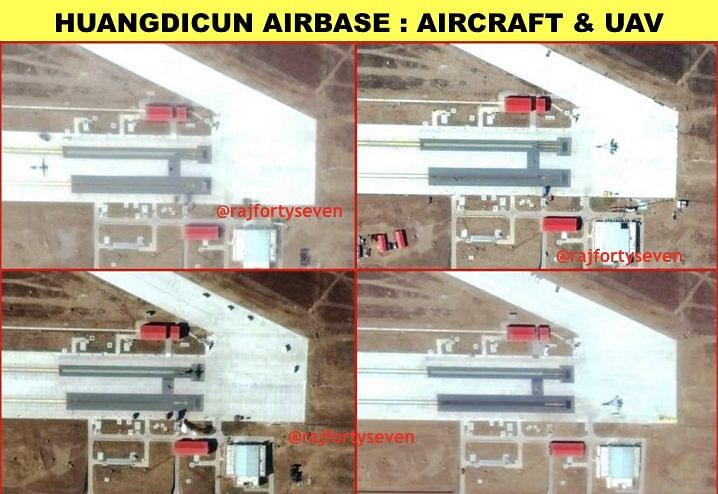
The aircraft usually observed on this airbase are J-15, which are the basic naval aviation backbone developed based on Su-33 of Russian origin. It has features such as missile approach warning system (MAWS), glass cockpit, tail sting and WS-10H engines with improved thrust for ski-ramp take offs.
UAVs and JL-9s have also been observed on this airbase. The presence of JL-9, in addition to J-15 aircraft, on the airbase suggests higher pilot to aircraft ratio.
The UAVs seen on the catapults suggest the future Chinese carrier vessels will have UAVs with CATOBAR (a system used for the launch and recovery of aircraft from the deck of an aircraft carrier) version.
Ski ramps and arrested landing area

There are two ski ramps on the second runway, half the length of primary runway. Facing opposite directions, these two provide a different take-off experience. The ski ramps have exactly similar size and possibly angle of launch as that of the Liaoning aircraft carrier. The launch positions have been marked on the runway to denote carrier vessel’s shape and exact distance on the carrier deck.
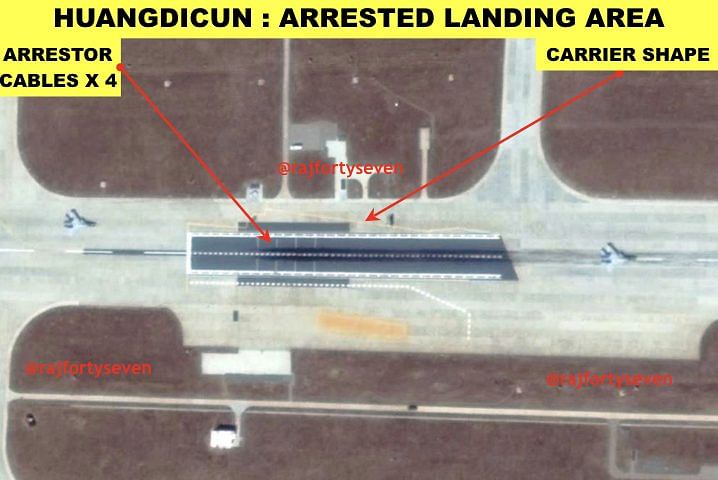
There are two arrested landing areas marked on the main runway. The arrested landing area in the south has a set of four arrestor cables similar to Liaoning carrier vessel. But the second arrested landing area in the north has only three cables. This indicates possible future carrier vessel’s landing area on a CATOBAR version.
Catapult-assisted launch facility
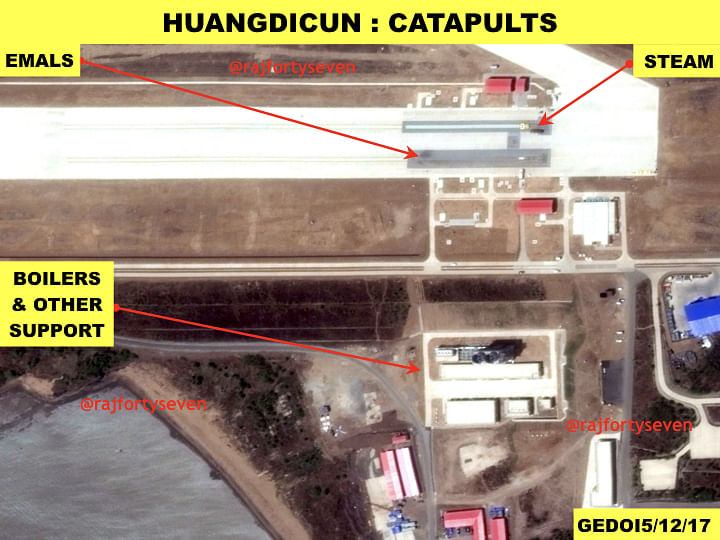
The upgrading of Huangdicun in 2015-16 was mainly to construct a catapult-assisted launch facility for future carrier vessels.
There are two types of catapults constructed. The size and shape suggests that the western one is steam and eastern one is electromagnetic-assisted launch system or EMALS. The length of both catapults indicates launch stroke of 100-125 m, acceleration achieved would be more than 10G with a cycle time of 40-50 seconds.
Learning from accidents

The Chinese PLANAF, although new to carrier aviation, has done very well in terms of accidents. The US carrier aviation in the early 1950s had suffered many losses due to accidents. China probably has learned its lessons theoretically rather than learning it practically.
There have been three accidents, two of them fatal. Both fatal accidents occurred in the month of April 2016. The first one was on the ground training facility at Huangdicun and the other was on board Liaoning.
Two of these accidents could be identified on the satellite imagery much before the official announcement. The first one was identified in the last week of June 2016 from the remains of burn marks on the grass, approximately 700 m from the first arrestor cable.
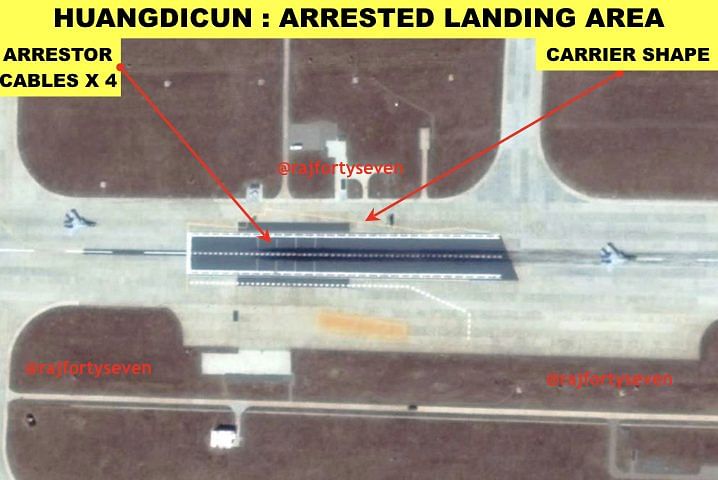
The second one was observed on the electromagnetic-assisted launch system where black scar marks at the end indicate a badly failed launch.
Second ground training facility
It is strongly rumoured that a second ground training facility for PLANAF is being constructed at an undisclosed location. The main contender for this honour seems to be the recently upgraded Zhanghe airport on the eastern side of Zhanghe Reservoir near Jingmen, Hubei. Although, there are no identifying signatures found as yet on this airport.
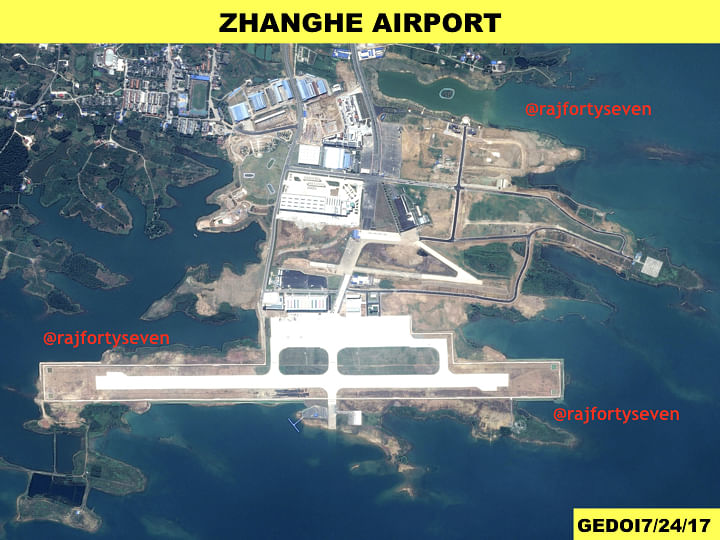
Implications
Indian think tanks and China experts have been rejecting the possibility of China having any credible power projection capability in the Indian Ocean Region (IOR) for the next two decades, especially since China doesn’t have any bases in the IOR.
Today, Pakistan, the Maldives, Sri Lanka, Bangladesh and Myanmar are more than willing to provide land for such bases. Also, China is nearing completion of its first overseas base in Djibouti, and is planning to build a similar facility in Gwadar, all of which raises the possibility of China’s power projection capability in IOR.
India needs to monitor the activities of PLAN and PLANAF very carefully. It also needs to boost its own facilities to produce aircraft and trained pilots.
Col Vinayak Bhat (retd) is a Military Intelligence veteran of the Indian Army with vast experience of satellite imagery analysis. He has worked as a Chinese interpreter and is a specialist on PLA and Pakistan’s armed forces. He tweets @rajfortyseven



